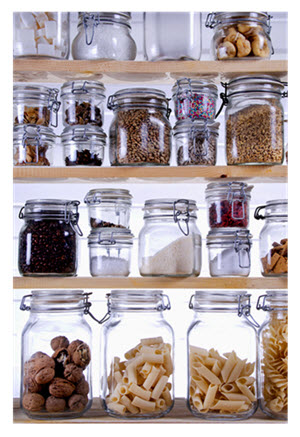 It was an annoying tiff over rearranging one of my kitchen cabinets, an irritation that seems to recur biannually as one of my sons (or an intimate) takes it into his head to ‘reorganize’ me.
It was an annoying tiff over rearranging one of my kitchen cabinets, an irritation that seems to recur biannually as one of my sons (or an intimate) takes it into his head to ‘reorganize’ me.
In addition to the kitchen cabinets, my less than beautiful pantry storage and fridge are also frequently under attack.
Naturally, the opinion that accompanies this unwanted assist is positioned as “a better system.” But much as I would love designer storage, I like my own systems, thank you very much – my visual mapping systems – by which I navigate my daily life.
“I have a visual memory,” I say, wearily or fiercely, not only protective of my ‘stuff’ but of my time, irritated as I find myself searching for what I can usually locate easily.
Organization “Systems” That Suit
My systems work for me, which isn’t to say that alternate, more efficient ‘workflows’ might not provide benefits.
However, when there is no recognition that I deserve buy-in (my house, my activities, after all), I’m miffed. And more so when there is no acknowledgement of the resulting learning curve, even as I resign myself to the fact that my ‘if it ain’t broke don’t fix it’ rule is often co-opted by, let’s just say it… testosterone.
In fact, on a recent road trip, disoriented (and aggravated) by various digital directives and devices that weren’t accommodating detours, construction, or the latest traffic jams, I insisted on stopping for a paper map. (Thank you Rand McNally.) Old School tool in hand, I was better able to forecast (and suggest) a variety of additional routes by which to continue our travels.
With the unblinking, unflinching, increasingly wrinkled paper in my hands – fully functional even in zones with no cell reception – not only did I feel more secure, but more independent. And, my visual mapping settled into the well worn habits of following the spidery veins of interstates, traced with my index.
Yes, we arrived at our destination. Yes, we also used several apps with inconsistent results. But we allowed ourselves greater latitude on the journey home, encouraging a side trip here, there, and (a delightful dose of) “everywhere,” as the paper map continued to accompany us in adventures we wouldn’t otherwise have shared.
Diagrams: Visual Thinking, Visual Learning
Now, “visual mapping” as I use the term may be better expressed as visual thinking, visual problem-solving, or even visual learning. In other words, I process information visually, (often) more effectively than with words. I also resolve intellectual puzzles with the use of diagrams, and always have.
Visual mapping may be defined as follows:
The process of translating visual thinking onto paper (or electronic paper) is visual mapping. A visual mapper combines words and images to create a visual record of the spoken and written words – literally revealing the “big picture.”
The advantages of this sort of thinking and learning are many, including the ability to see the big picture, interrelationships, and also, details.
Apparently, the visual mapping approach is true of my children as well. And thus, a digression: One of my sons is Mr. Technology and the other, while not technology-averse, is the epitome of the visual artist. This is another example of pictorial systems and their power, and the scenario was simple though it took me by surprise.
My son was required to take a prescription for a week after the flare-up of an allergy, and the directions offered a confusing description of days and dosage. I read them twice to (barely) understand, and I asked my son how he was keeping track.
“Diagram,” he answered, matter-of-factly.
“What sort of diagram,” I wanted to know, so he showed me.
A Nifty Example of Visual Mapping
On the small label affixed to the pill container, he had penned his own tiny infographic – a series of circles laid out in sets both horizontally and vertically, which he was crossing out at various times.
“Infographics are powerful, as long as they don’t reduce complex issues to deceptively simplistic interpretations.”
This was a comment he had made to me a few nights earlier – one I had to chew on (and he’s right) – as we chatted about the Internet, architecture, and the usefulness of various forms of communication.
 I thought of his prescription diagram, not exactly an infographic but certainly a close cousin, and wondered about the few medications that I take. I’ve seen those plastic containers labeled by day (I know several people who use them), but I have so few items to organize, I’ve never felt the need for one.
I thought of his prescription diagram, not exactly an infographic but certainly a close cousin, and wondered about the few medications that I take. I’ve seen those plastic containers labeled by day (I know several people who use them), but I have so few items to organize, I’ve never felt the need for one.
Is Your Memory Visual?
In my cabinets, which may appear disorganized to some, visual memory anchors me. Just as I am guided to each category of object on a shelf – drinking glasses, wine glasses, soup bowls, holiday cookie cutters – in similar fashion, I use a simple system of container placement to track whether or not I’ve taken meds or vitamins.
I place bottles on the right side of a bathroom shelf at night, and move them to the left in the morning after I’ve taken what I need. My son is essentially doing the same with his graphic: neatly marked dots and cross-hatching. I have “snapshotted” his approach in my brain for my own use in the future.
On a (tangentially) related note, I was tickled reading this column in The Times, “Real Adventurers Read Maps,” touting the advantages of a superior traveling experience with a tactile collaboration involving highways, byways, and an awkwardly folded, traditional aid. I was able to picture my own recent experience of traveling by car (hundreds of miles), then meandering home with confidence thanks to the tried-and-true pleasures of an old-fashioned map.
As for my cabinets and pantry? I’m awaiting the next well-intentioned but unsolicited salvo. Unaware of its timing, with “boys” about the place, I’m certain it will come.
You May Also Enjoy
It’s interesting that your men are reorganizing your kitchen since both of those are typically female roles. It sounds like they were just trying to make your life easier. Have you let them know that your current method works best for you?
I don’t think I’m great at seeing the big picture, but I do love visual mapping and often do it for myself and others.
Ms. HalfEmpty, lovely to hear from you! Actually, while well-intentioned, I think they’re trying to make their lives easier and believing that mine will be as well. The reorganization typically follows their functional needs and not my own. While this isn’t necessarily a problem, it can be… when they place everyday items out of my reach, as their “viewpoints” stand roughly 8 inches taller. 😉
Height is a definite issue. My mom is 5’2″ and the guy installing her new kitchen appliances was over 6 feet tall, so he installed the convention oven so high above the regular oven that she would never be able to reach any of the buttons without a stool. He ended up redoing that installation!
🙂 Exactly!
My brain doesn’t work this way but I sure wish it did. For many reasons. It’s such a good skill to have.
A few years ago, we took a family trip to Disney. My husband’s favorite electronic map was telling us to take a particular route that just didn’t sound right to me. So I got out the old fashioned paper map (that I had brought, of course) and found the correct route. My husband usually takes the electronic map’s directions as law, but I was able to persuade him to follow my route, which got us there perfectly. The electronic map had calculated the route based on incorrect GPS information, and was, in fact, wrong. The kids are still talking about “the time the REAL map was better than the electronic map”!
I hear you on that one, KT! Also my experience, most recently.
YES! I finally CLEANED the pantry as the husband requested. But Like you I can find what I need cause I put it there! AS far as pills I like the moving the bottle bit! THANKS!